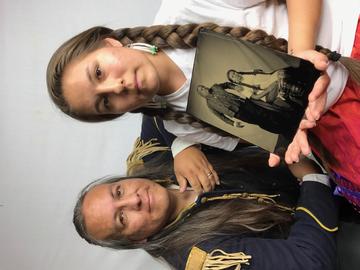Interview with Dakota Goodhouse
by exhibition curator Christopher Morton
CM: Shane Balkowitsch uses a nineteenth-century photographic method, the Ambrotype or Wet Plate Collodion Positive. Are both you and Shane consciously evoking the history of photography of Native American people from that period in creating these new portraits?
DG: No. I think non-natives are as enchanted with the process of wet plate photography as native people. It feels like a retroactive experience. The science that allows me to understand the chemical reaction and energy in this process is at odds with the experience of my grandparents and great-grandparents. The Lakota observe this reaction of chemicals like this as "Kxan," which means "energy," and the portrait that is revealed becomes "Wakxan," or "With-Energy." Missionaries translated this word, "Wakxan," as "Holy," or "Sacred."
When I held myself still for Shane's portraits, I wondered what might my relatives have thought. Pain? Anger? Loss? Sadness? Were they filled with hope? Did they wonder if their descendants would see them? I found myself feeling those things as I wondered, and those old historic portraits suddenly became more meaningful. We are still here.
Shane's art is meaningful. There is no exchange of money, only time. People arrive as sitters and leave as friends. His indigenous participants and audience celebrate his art. Because Shane uses shadow and reflection to create his portraits, and because it takes time to prepare, there is a charge in the air that feels distinctly mystic. The seconds it takes to capture an image are often silent, almost spiritual moments. The world needs more quiet meaningful exchanges.

CM: Is it a way of taking ownership back over this history of representation?
DG: Some might see it that way. There are native photographers, but I don't know if there are native wet plate photographers. Certainly, native artists own the representation of their own narratives. Natives as subjects in Shane's art present themselves in ways that make them comfortable. They choose what they want to wear and how they want to be seen. There are no predetermined static poses. This is the dynamic in Shane's art that is not present in the portraits of the nineteenth century.
CM: Frank White Bull suggests that he felt a connection to his ancestors through sitting for his portrait with Shane - was this the same for you?
DG: I feel a connection with relatives and ancestors through ritual: when I start the day with a drink of water; when I see male relatives and clasp my left hand to their right shoulders; when I put a plate of food out for relatives; when I stand at a special site; when I dance at the pow-wows; when I have ridden horse; and when I eat special foods during holidays. I think the preparation for sitting for one of Shane's portraits feels like a sacred rite. Men and women brush their hair, dress a certain way in their best, and maybe even paint their faces. This certainly feels like I'm taking the same steps as relatives - following the same steps as relatives. Maybe I'm even thinking of the same things they did. Maybe I wonder too, how relatives four generations from now will look and see me. I wonder if they will have the same hopes and dreams as I.
My grandfather was an Anglican priest at St. Luke's on the Standing Rock Sioux Indian Reservation. When I step into church whether it's on the reservation or off, through ritual experience my grandfather is with me.

CM: What is your feeling about the portraits now that you have them, and do you display them at home, etc.?
DG: When I went to school, I received a good western education. I learned about the sciences. I learned empirical reasoning. After school, I raced home to watch Transformers, G.I. Joe, and MTV. But I also learned what my teachers brushed off as superstition. Once when a bird flew into my mother's kitchen, down the hall, and out the front door, my heart dropped and goosebumps immediately pebbled my skin. My first thought was that it brought a message that someone close to me was going to die soon. A natural scientist might say, "well, it was probably just looking for a place to nest." And maybe it was.
When I saw my portrait appear in the glass at Shane's studio, my heart was moved and my mind was racing. Goosebumps rose on my skin as though lightning was in the air and I was about to be struck. I was nearly overwhelmed with the impulse to seize my own portrait and smash it on the ground to free myself. It felt as though I were in a rush of air before a thunderstorm. Then the moment passed in the blink of an eye. I felt a release of pressure as though my ears were closed to the sounds of the world and I could suddenly hear again. Did I just imagine all this? I beheld my own image before me in a way I've never experienced
It would feel self-aggrandizing if I displayed my wetplate at home. Maybe someday, a descendant might display my wetplate in his or her home.
I imagine I would feel the same if the British Museum opened their collections to me to view my ancestral Winter Count. My grandmother was just a little girl and recalls seeing it. She told me all about it, but seeing it online would not be the same as in person. I think I would well up with emotion seeing and feeling something that was missing from my family for so long.


